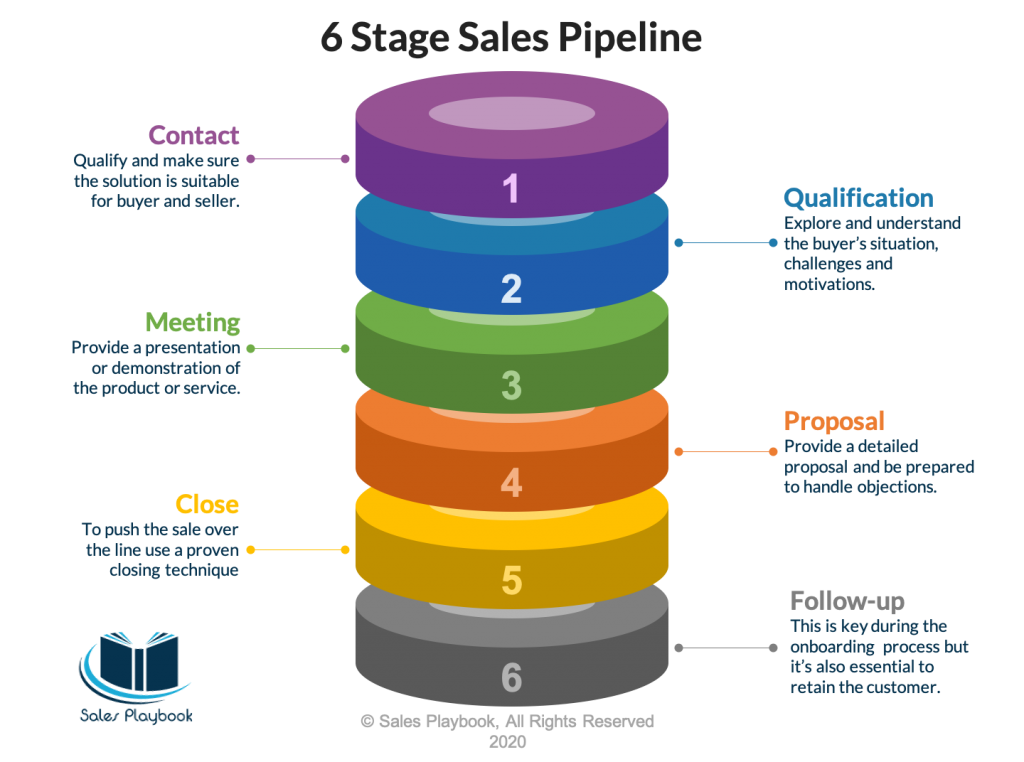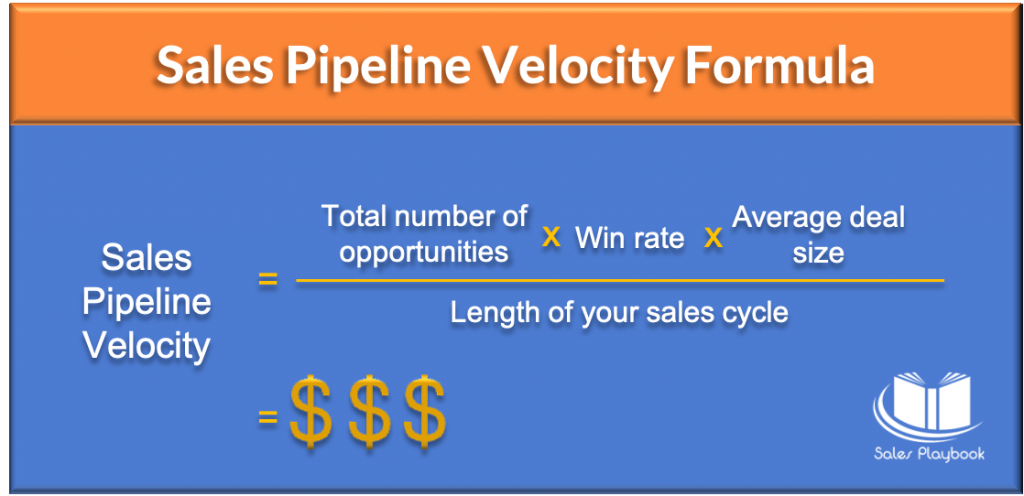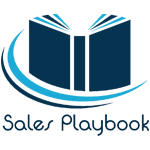
A sales pipeline is the actions a sales rep takes during the sales process and it’s one of the most important tools a sales professional will use during their career. A sales pipeline is how a sales team calculates how many prospects they are working with at any point and at what stage those prospects are in during the sales cycle. Making sure you improve your sales pipeline and review, clean and update this regularly is imperative to your success. A well maintained pipeline will allow you to more accurately track your opportunities, where and why they drop out and better forecast your numbers to senior leadership.
The stages in a sales pipeline may vary depending on a company’s industry and complexity of a product or service, but for the purpose of this article we will be looking at a six stage sales pipeline for business. Once your preferred sales pipeline is in place this information should be included in your company’s Sales Playbook.
Sales Pipeline vs Sales Funnel
Although a sales pipeline and sales funnel are used by many in the same context this is incorrect. A sales pipeline is the actions a sales rep takes throughout the sales process and a sales funnel is the stages buyers goes through during the journey to become a customer.
Sales Funnel: This is used by sales leadership teams to gauge a total number of buyers that are in each stage of their journey.
Sales Pipeline: This is the actions every sales rep takes to develop a prospect into a customer or from initial contact to follow-up as per the stages in this pipeline.

1. Contact
A sales pipeline begins with someone becoming interested in your product or service. This will typically be through four routes:
- Your marketing team will generate interest through paid or organic channels
- Your sales team or development team will generate interest through cold outreach
- Prospects will find your products or service during an internet search
- Referrals/word-of-mouth – generally through happy customers
Once a lead has been generated, the sales or development teams will make contact to initially qualify and make sure that the solution on offer is suitable for both buyer and seller, along with other factors. Sales resources which can be found in your company’s Sales Playbook can be used during this stage. Testimonials, white papers and customer stories are all good sources of information to incorporate into your pitch or general conversation while peaking the prospects’ interest. These can then be provided via email, social channels or even post to validate the information discussed.
My article Frameworks for Lead Qualification can provide structure for the beginning stages of your pipeline.
2. Qualification
After the prospect has been identified the next stage is to fully qualify them, which means exploring and understanding their situation, challenges and motivations. At the same time the customer will be learning more about your company, product and service, but more importantly about you. This is a real opportunity to start building a strong relationship. The prospect has typically agreed to a second phone call or video conference and booked time out in their diary specifically for you, this is your chance to make a great impression, but also to complete an in-depth discovery.
This stage of a pipeline can take time depending on factors like the complexity of a product or service. It is important to stay patient and gather as much information as possible to prepare fully for the next stage. Asking a mixture of open-ended questions along with closed-ended questions will enable you to better understand the prospect and show that you’re interested and invested in them. Remember this stage is also important to potentially qualify out the prospect as well, if they are not going to be a fit then there is no point wasting any further time guiding them along the other stages.
A company’s sales methodology is important in the contact stage of your sales pipeline, but it will really come into its own from this point onwards. My articles The Right Sales Methodology and A Brief History of Modern Sales Methodology can provide more information on this subject.
You should be able to find a list of qualifying questions for this stage in your company’s Sales Playbook.
3. Meeting
Now that the qualification has been done and a relationship has been established with the buyer, you’re all set to book a meeting either in person or via video conference to provide the potential customer with a presentation or demonstration of the product or service you’re offering to solve their challenges previously discovered.
This is a key stage and potentially a make or break situation. You have discussed during qualification the details related to the prospect’s business, current or previous supplier(s), what has worked and what hasn’t and details on what their preferred end goals would look like. Now’s the time to put all that hard work to use and provide your best presentation or demonstration.
Meeting Tips:
- Practice with your colleagues and/or manager if needed before the day
- Review the steps of the presentation created and make sure everything is included
- If the prospect was particularly excited about a certain feature or benefit make sure to put a little more focus here
- Relax and let the meeting flow
Examples of successful presentations and/or demonstrations should be included in your company’s Sales Playbook. If you absolutely nailed a meeting with a prospect make sure you relate how and why this happened to your senior leadership team, so that this can be included in the playbook and your success can be rolled out to help others in your team.
4. Proposal
This can sometimes be done during the meeting stage, but depending on the product or service the client may require specialist pricing, amended terms etc, so a detailed proposal will typically be sent after the meeting.
In any event this is the moment you will effectively ask your prospect to become your customer.
Best practices:
- Make the proposal clear and concise
- Reiterate the key information you have discussed with the prospect
- Make your correspondence about the customer and their challenges and how the specific features and benefits meet their requirements. Remember it’s always about them and not about you
- Propose multiple options at different price levels if this will help
- Always list your price points from high to low
Once the prospect has received the proposal it is likely you will receive objections, so be prepared to handle these. Objections will typically appear throughout the entire cycle of a sales process, but it’s common for buyers to have objections or require clarifications at this stage before they agree and sign up to using your product or service.
My article Framework for Objection Handling can provide more information.
Proposal examples should be included in your company’s Sales Playbook.
5. Close
You’ve provided the potential customer with a proposal but they haven’t signed it yet. This is where having a closing technique to push the sale over the line will come into play.
There are hundreds of closing techniques, tips and tricks, but the most important thing to remember here is that this is not a stand-alone event and by completing all previous stages properly and in order will considerably increase the chances of the close. Below are four closing techniques for you to consider:
- The Assumptive Close
Probably the most common closing technique used in sales today. The assumption close works if you have completed all steps of the sales process successfully and have the right to assume the sale is a done deal. If you have not been successful in prospecting, discovery, delivering the right product and value in your demonstration or answered the objections satisfactorily, then this close can simply turn into a pretentious push.
When deploying this technique you should continually assume that the buyer will become a customer from the very beginning, so that when you get to the proposal or closing stage it’s all about when the prospect will start using the product or service. You will feel confident in saying to the buyer examples like “Now that we have confirmed everything, how does Tuesday work for delivery?” or “ok great, well the good news is we can have this all in place for you by Friday this week!”
- Summary Close
This close works great when you have gone through an extensive evaluation over a period of time. Sales professionals using the summary close will reiterate items discussed and laid out in the proposal by stressing the value and benefits of the product offering to ease the prospect towards the finish line. An example would be:
“We have the three piece suit in gunshot grey, the tailored footrest with built in storage, complete with a 2 year warranty and nothing to pay for the first 6 months. We can delivery that free for you, shall we say Thursday morning?”
By summarising the points previously agreed and articulating the package, you’ll help the prospect visualise exactly what they are getting from the deal. Making sure you emphasise specific features or benefits they have highlighted as key is critical as this will excite the buyer and hopefully make them want the product or service sooner rather than later.
- The Something for Nothing Close
This is a close technique deployed in many organisations, especially in competitive markets. The technique works by giving the prospect a discount for first time buyers, a free period of usage or a free add-on which will benefit their purchase. The offering is made to secure the purchase in return. Offering a specific benefit or add-on for free can also set up potential cross-sell or upsell opportunities later on, so it can be a good business decision depending on your offering.
The something for nothing close works because people like free things as long as the offering is of value for them. If done correctly and your company has structure around this approach it can be highly lucrative to a business when selling additional products or services at a later date.
- The Urgency Close
Also referred to as the “now or never close” this is where you put pressure on the prospect to make a purchase. An example would be if you have offered the prospect a discount when the proposal was supplied you would use this when deploying this technique. If the buyer said “Let’s catch up next week” you would respond “Ok no problem, but I have to let you know that the discount we applied in your proposal will only be available to purchases made this week. I don’t want you to miss out.”
In this technique you are putting a time limit on the purchase and the fear of the prospect missing out pushes the sale across the line.
There will be two outcomes from closing. You will mark this as “Closed Won” and progress to the Retention stage or you will mark this as “Closed Lost.”
For more closing techniques read my article Closing Techniques Explained
Examples of closing techniques should be included in your company’s Sales Playbook.
6. Follow-Up
Congratulation, you closed the sale and brought a new customer to the company, but now the stage of retaining that customer begins.
Depending on the size and structure of your company, the new customer may be passed to an account management or customer success team to be looked after in the future. If your company does not have this structure or something similar then the customer will remain with the sales rep that closed the sale and it will be their responsibility to retain that business.
It’s important to follow-up regularly, especially during the onboarding process. You want to make sure that the customer feels you’re invested in them for the long haul and not that closing the business was the only interest. Companies will generally have a target for retaining business in order to lessen their churn rate. There should also be a target/quota in place for upselling and cross-selling to existing customers to make sure their sales reps are keen to continually nurture customers and this should be included in their compensation plan explained in your company’s Sales Playbook.
Even if the new customer is passed across to another department, targets and compensations should be set out accordingly to incentivise that team. Happy customers make excellent candidates for upselling and cross-selling, so that the company can make the most out of all growth opportunities.
Knowing Your Sales Pipeline Velocity
A sales manager or director will typically deal with the metrics for a sales team, but there are a four that sales reps can focus on to maintain and improve performance to continually achieve or exceed their target/quota. These are:
- Total number of opportunities
- Win Rate
- Average deal size
- Length of sales cycle
Knowing these metrics will enable you to calculate your pipeline velocity. The formula for this is:

If you have 60 opportunities in your pipeline, the average win rate is 30%, the average deal size is $15,000 and your sales cycle from contact to close is 60 days. Your pipeline velocity = 60 x 0.30 x $15,000 / 60 = $4,500
That means you will have $4,500 moving through your pipeline on a daily basis. Tracking this number can keep you focused on a creating a faster pipeline, with more opportunities, more value, higher win percentage and all in a quicker time frame.
Simply put, to increase overall pipeline velocity play with these metrics. Increase your opportunities, win rate and average deal size or decrease the length of your sales cycle. If you can do both then you will be on your way to sales superstardom!
More revenue, less time!
The Importance of the CRM
The data stored in your company’s CRM is incredibly valuable not only to sales professionals but to the entire organisation. However, a CRM is only as effective as the quality and consistency of the information it holds. According to Gartner more than 25% of the data held by most companies is likely to be inaccurate. I have experienced this in companies I have worked with over the years, with incorrect contact details, employees who have left their organisation, incorrect industry labels amongst many, many others.
Sales teams and account management or customer success teams are the best placed to make sure this information is up to date. Most sales professionals don’t particularly enjoy inputting data into the company CRM and senior leadership, in many cases, overlook or do not reinforce the need to clean and update one of the most important and costly business tools, which can be a huge mistake.
Make sure you update the CRM in real time or as close to as possible, remove duplicate accounts or push this up the ladder to your manager if you don’t have the required permissions. If contact details are incorrect, remove and replace, fill in the missing fields and if new fields need to be added to the CRM then make your manager or CRM team aware immediately and let them know how this would be beneficial.
If a company has a sales development team in place they are ideally positioned to get a substantial amount of initial information around the leads coming into a business and the prospects they are researching. Having KPIs in place is a great way to maintain the health of a company’s CRM.
The information a company requires sales professionals to input and maintain in their CRM should be included in the company’s Sales Playbook along with a full section on how to use and manage your sales pipeline.
In Conclusion
Your sales pipeline is yours to manage and if done correctly will have a huge impact in your sales success. Review, clean and increase your pipeline regularly to maintain the best possible data, input all notes and complete the fields in the CRM as you move prospects from one stage to another. Practice your presentations, demonstrations and consistently review your close techniques. Make improvements as and when needed and you will consistently achieve or exceed your target!
“Keep your sales pipeline full by prospecting continuously. Always have more people to see than you have time to see them.”
Thanks for reading. If you enjoyed this article please like below and share on your social channels.


